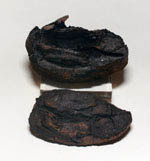Tucked upstairs in a small room I felt awkward. It was strange to be at Le Cordon Bleu without my uniform.
Sixteen place settings. Sixty-four wine glasses. One huge map of France. Tonight began
Wine Essentials – an elective wine education class. Of the 16 students, only four are from my culinary program. The balance are locals brushing up on wine knowledge.

The program has been designed to supplement the
Diplôme de Cuisine.
Wine Essentials to be taken concurrently with
Basic Cuisine.
Wines of France with
Intermediate Cuisine.
Wines of the World with
Superior Cuisine.
For 18 weeks we will learn, discuss, and taste wine. Always tying back to cuisine.

Our instructor, Didier-Edgar Allix, is a “Tasting Expert.” Professor of Wine. Expert to the Court of Appeals of Paris. Jury member of international competitions. Honorary President of La Compagnie des Courtiers Jurés-Expert Piqueurs. And French, of course.
There is something flowery or romantic when you hear a Frenchman describe wine. It becomes much more “alive” than fermented grape juice.
Lesson #1 – Sensory Analysis – Introduction to Wine TastingWine is more than just drinking it. Sight (color) determines age, grape, and alcohol content. Smell informs the taster of intensity, defectiveness, and expected flavor. Taste produces a flavor and reaction (
l’attaque) on the palette. Collectively summarized.
There are three factors that can influence the senses. Local – where the tasting is being done. Ideally wine should be tasted in bright daylight. In a room with white surfaces that is clean and smoke-free and without strong odors.

The glass. The
Institut National des Appellations d’Origine, INAO, has developed a tasting glass that has been internationally adopted. It has a short stem and narrows at the top – helping to keep the wine free from your hands and the aroma in the glass.
The taster. The taster should be in good shape, well rested, and must avoid strong smells. It is recommended to work on an empty stomach and before noon – when taste is most receptive.
These, of course, are the recommendations for professional wine tasters. Those that taste (not swallow) 50-some wines per day. For the wine consumer – drink when, where, and how you want….following the proper method.
Tasting Wine
First look at the wine. Tip it back on a white surface and determine its color. Darker, more orange, tends to mean older in age. Pink and rose colors suggest a younger wine. Determine whether the wine is clear, bright (reflects light), or oily.

Next. Smell the wine. It should smell as fruity as possible – what is the intensity? Is there a
clean nose – does it smell “normal” without any defects. If wine is bad you can usually smell hints of vinegar, cork, or mold. Finally, determine the initial and secondary “noses.” First, categorize the smell into one of the aroma families. Then into a sub-category. Lastly name the specific smell.
For example, the
St. Nicholas de Bourgueil 2008 that we tasted looked like this:
Aroma Family - Fruit
Sub-Category - Black fruit
Specific Smell - Blackberries and currants
We also detected some spice - ground black pepper - on the second nose.

Finally. Taste. In three parts. First, l’attaque – how the wine first hits your palette. Second, how the wine evolves,
evolving taste. Third,
la suite, the finish – how long does the wine hold up.
Once you have looked, smelled, and tasted the wine then conclude. First of all. Did you like the wine? Secondly. Was there general harmony? That is to say, the sight, smell, and taste were in balance.
Back to our
St. Nicholas de Bourgueil 2008 example,
There was disparity between the strong, floral nose and the fruit-less taste. This wine did not have general harmony.

With a foundation of how to taste wine we will begin looking at wine and food pairings in next week’s class.
Session #1 Tastes
- St. Nicolas de Bourgueil (cépage, cabernet-franc) by Frédéric Mabileau, 2008
- Chénas (gamay) by Trenel, 2007
- Sainte Foy Bordeaux (merlot, cabernet-sauvignon, cabernet-franc) by Chateau de Champ des Treilles, 2007
- Côtes du Rhône (Grenache, syrah, carignan) by Mas des Roches, 2007








































.jpg)








